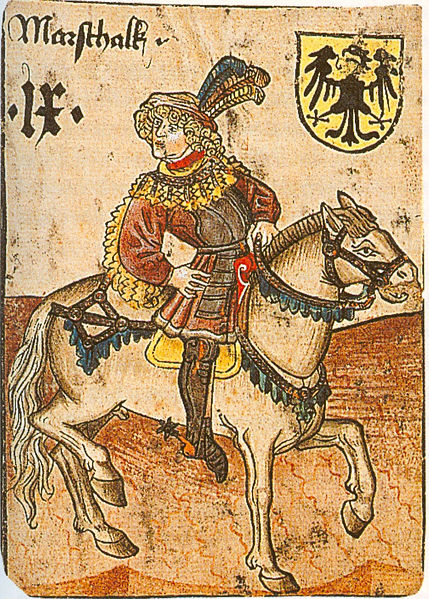Cards in Medieval Times
There is evidence of card decks all the way back to the 13th century in Europe but cards were made of different materials back then and “suits” didn’t come along until the 1500s. Medieval cards were not made of paper but wood and adorned with Arabic symbols. Card games were for kings and royalty and thought of as an expensive hobby for the wealthy.
Paper decks of cards were first seen in the early to mid-1400s and their designs boasted kings, knaves, and chevaliers—queens were added later. It was this century where cards began to change when French cards were made using images of gods, heroes, and heroines.
In the 15th century, paper cards were the norm and were comprised of 52 cards. Royalty images were still present on cards in Europe; however, the 15th century saw the beginnings of suits. Each European country had their own suits—the Germans used hearts, hawk bells, leaves, acorns, swords, and batons. Coins and cups were used in Spain and Italy. The cards we use today in our favorite no deposit online casinos came from France and England. These two countries first implemented hearts, spades, diamonds, and clubs.
Gambling for Outlaws Only?
Image via Flickr aresauburn™
In the Wild West, respectable citizens didn’t partake in poker card games in bars or saloons. From Dodge City, Kansas, to Tombstone, Arizona, to all the mining towns in between, rarely were gentlemen and ladies involved in poker or faro.
Gambling houses of chance may have been popular in the Old West from the early 1800s through the early 1900s but it was the outlaws who favored card games and some such as Doc Holliday proudly claimed it as their “profession.”
Three-Card Poker Games
Image via Wikimedia Commons FabriQate
By the 17th century, India and Southeast Asia had their own favorite game,Teen Patti, also known as “flush” or “three card bags.” Still played today, players bet on three cards hoping for the highest hand. The game “Poque” came from France and is the closet to what standard poker is today and included “bluffing.” Germans also claim to have invented tri-card poker with a game called “Pochspiel” that finally became known as “Poque.”
Although historians have trouble agreeing to the origins of poker, the Irish also claim bragging rights with their three-card game of “Poca.” Tri-card poker was not as popular in Spain and Italy where four cards were used in a game called “Primero.”
It was England who changed Primero to a three-card game called “Bragg.” Brag is still played today—notice the second “g” has been dropped. So, it’s tough to say which country can actually claim they invented the game, but what is amazing is that many of these games are played as they were centuries ago.
Biggest Winners and Losers
Image via Flickr Play Among Friends
Which player has won the most and who has walked away broke? Antonio Esfandiari of Las Vegas has won more than any other tourney player ($23+ million as of 2012). Gus Hansen dropped a little over $3 million in the 2012 poker championship in Vegas and lost another million playing PokerStars online.
Poker and its variations still entice and amuse us and the popularity of online casino card games has reached an all-time high. What’s your favorite card game?
